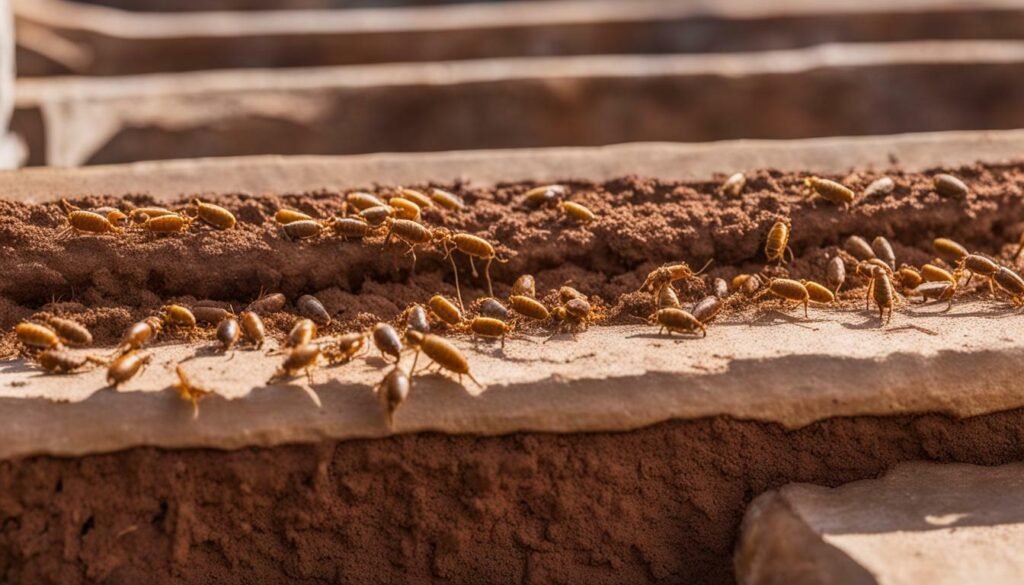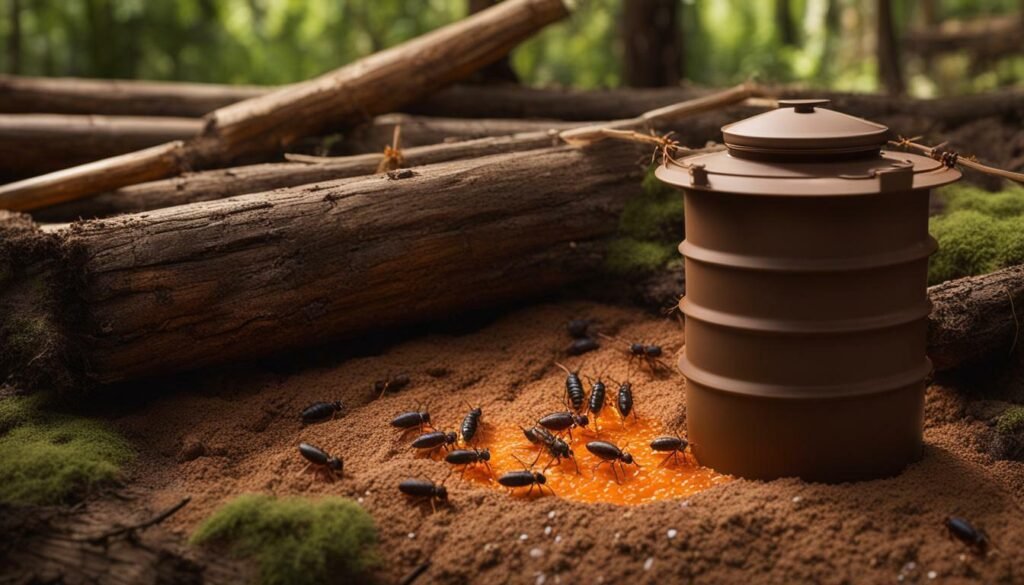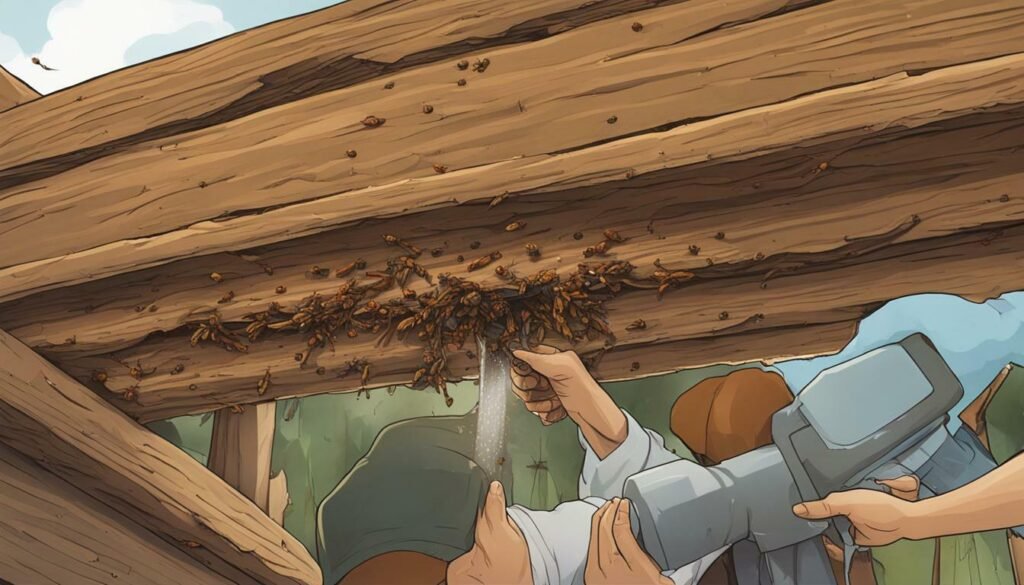When it comes to protecting your home from termite damage, there are two popular methods to consider: liquid termite treatment and baiting. Each method has its own strengths and weaknesses, and understanding the differences between them can help you make an informed decision for your termite control and prevention needs.
An effective liquid termite treatment involves creating a barrier around your home using a termiticide. This barrier acts as a deterrent, preventing termites from entering your home and causing damage. However, liquid treatments do not actively kill the termite colony, meaning that the root cause of the problem may still persist.
On the other hand, termite baiting is a process that targets the entire termite colony, including the queen. Bait traps are strategically placed around your property and filled with termite bait mixture. This bait attracts termites away from your home and ultimately eliminates the colony. While baiting may take some time to completely eliminate the infestation, it addresses the underlying cause of the termite problem.
Now that you understand the basics of liquid termite treatment and baiting methods, let’s take a closer look at their pros and cons, as well as the factors to consider when choosing the right method for your specific situation.
Key Takeaways:
- Liquid termite treatment creates a barrier to prevent termites from entering your home, but it does not actively kill the termite colony.
- Termite baiting targets the entire colony, including the queen, but it may take time to completely eliminate the infestation.
- Combining liquid termite treatment and baiting methods offers comprehensive termite defense.
- The choice between the two methods depends on factors such as the severity of the infestation and personal preferences.
- Regular termite inspections and professional assistance are crucial for effective termite control and prevention.
Understanding Liquid Termite Treatment
Liquid termite treatment involves creating a protective barrier around your home using a specialized termiticide. This barrier is applied to the soil surrounding the foundation, creating a zone of protection that termites cannot pass through. The termiticide works by either repelling termites or killing them upon contact. This method is highly effective in preventing termites from entering your home and causing damage.
When applying liquid termite treatment, a professional will carefully assess the perimeter of your property and identify areas where termites are likely to enter. They will then use specialized equipment to apply the termiticide to the soil, ensuring thorough coverage. The termiticide creates a barrier that termites cannot cross, effectively deterring them from accessing your home.
It’s important to note that while liquid termite treatment is highly effective in preventing termite infestations, it does not actively kill the termite colony. If termites have already established a colony within your property, additional measures may be necessary to eliminate them completely. In such cases, a combination of liquid termite treatment and baiting methods may be recommended for comprehensive termite control.


| Pros of Liquid Termite Treatment | Cons of Liquid Termite Treatment |
|---|---|
| Effectively prevents termites from entering your home | Does not actively kill the termite colony |
| Long-lasting protection with regular maintenance | May require professional application for optimal effectiveness |
| Minimal disruption to your daily life during treatment | Does not address the root cause of the termite problem |
Using liquid termite treatment is a proactive way to protect your home from termite infestations. By creating a barrier around your property, you can significantly reduce the risk of termite damage.
Conclusion
Liquid termite treatment is a highly effective method for preventing termites from entering your home. However, it does not directly address the root cause of the termite problem, which is the termite colony itself. To ensure comprehensive termite control, it is often recommended to combine liquid termite treatment with baiting methods. This approach targets both prevention and elimination, providing the best defense against termites.
Exploring Termite Baiting Method
Termite baiting is an alternative method that focuses on attracting termites away from your home and eliminating the colony. It involves the use of bait traps, which are strategically placed around the property to entice termites. These bait stations are filled with a termite bait mixture that contains poison designed to kill the termite colony, including the queen. Once termites discover the bait, they consume it and bring it back to the colony, ultimately leading to the demise of the entire termite population.
Unlike liquid termite treatment, which creates a barrier to prevent termites from entering the home, bait traps actively target the root cause of the termite problem. By luring termites away from your property, baiting methods help ensure that the colony is exposed to the poison, resulting in its eventual eradication. However, it’s important to note that termite baiting may take time to completely eliminate the infestation, as it relies on the termites spreading the bait throughout the colony.


The Benefits of Termite Baiting
Termite baiting offers several advantages over other termite control methods. First and foremost, it provides a targeted approach to termite extermination, focusing on the colony rather than just preventing termites from entering your home. By eliminating the colony, bait traps help ensure long-term protection against future infestations. Additionally, termite baiting is environmentally friendly, as it involves the use of non-toxic bait materials that do not harm other beneficial insects or animals.
The Limitations of Termite Baiting
While termite baiting can be highly effective, it does have some limitations. One key limitation is the time it takes to eliminate the entire colony. The process can span several weeks or even months, as termites must actively consume and spread the bait throughout the colony for it to be effective. Additionally, termite baiting may not be suitable for every infestation. In cases where the termite population is widespread or the infestation is severe, a combination of baiting and liquid termite treatment may be necessary for optimal results.
| Pros of Termite Baiting | Cons of Termite Baiting |
|---|---|
| – Targets the entire termite colony | – May take time to eliminate the infestation |
| – Provides long-term protection | – May not be suitable for severe infestations |
| – Environmentally friendly |
In conclusion, termite baiting is an effective alternative to liquid termite treatment that focuses on eliminating the termite colony. By strategically placing bait traps and using non-toxic termite bait, this method offers targeted extermination and long-term protection against future infestations. While it may take time to eliminate the entire colony, termite baiting provides an environmentally friendly approach to termite control. Consider the severity of the infestation and consult with a professional to determine whether termite baiting is the right choice for your home.
Pros and Cons of Liquid Termite Treatment
Liquid termite treatment offers several benefits but also comes with a few drawbacks to consider. One of the major advantages of this method is its effectiveness in preventing termites from entering your home. By creating a barrier around the house using termiticide, you can significantly reduce the risk of a termite infestation. This is especially important for homes located in areas with high termite activity. Additionally, liquid termite treatment is relatively easy to apply and can provide long-lasting protection against these destructive pests.
However, it is important to note that liquid termite treatment does not directly address the root cause of the termite problem – the termite colony. While it can prevent termites from entering your home, it does not actively kill the entire colony. This means that if there is an existing termite infestation, the colony will continue to grow and cause damage. It is essential to combine liquid termite treatment with other methods, such as regular inspections and baiting, to fully eliminate the infestation.
liquid termite treatment does not directly address the root cause of the termite problem – the termite colony.
Another drawback of liquid termite treatment is the potential risk to the environment and non-target organisms. The termiticide used in the treatment can be harmful if not applied correctly or if it seeps into the surrounding soil or water sources. It is important to follow the manufacturer’s instructions and consult a professional to ensure safe and effective application. Additionally, liquid termite treatment may require reapplication over time, adding to the overall cost of termite prevention and control.
In summary, liquid termite treatment offers effective prevention against termite infestations and is relatively easy to apply. However, it does not directly eliminate the termite colony and may carry environmental risks. To achieve comprehensive termite defense, it is recommended to combine liquid termite treatment with other methods, such as termite baiting, to address the root cause of the infestation. It is also important to consider factors such as the severity of the infestation and personal preferences when choosing a termite control method.
Pros and Cons of Liquid Termite Treatment:
| Pros | Cons |
|---|---|
| Effectively prevents termites from entering your home | Does not actively kill the entire termite colony |
| Relatively easy to apply | Potential risk to the environment and non-target organisms |
| Provides long-lasting protection | May require reapplication over time |


Pros and Cons of Termite Baiting
Termite baiting has its advantages and disadvantages, making it important to weigh the pros and cons before choosing this method. One of the major advantages of termite baiting is its ability to target the entire termite colony, including the queen. By placing bait stations filled with termite bait mixture around the perimeter of your home, you can attract termites away from the house and ultimately eliminate the infestation at its source. This method not only kills the termites that come into contact with the bait but also disrupts the entire colony’s ability to reproduce and thrive.
Another advantage of termite baiting is its relatively low impact on the environment compared to liquid termite treatment. Since the bait stations are strategically placed around the property, only the termites that come into contact with the bait are affected, minimizing the potential harm to other beneficial insects and wildlife. This makes termite baiting a more eco-friendly option for termite control.
On the downside, termite baiting may take time to completely eliminate the infestation. Termites are known for their ability to multiply quickly, and it can be a waiting game to ensure that the entire colony is eradicated. Additionally, termite baiting requires regular monitoring and replenishing of the bait stations to ensure continued effectiveness. This ongoing maintenance can be time-consuming and may require assistance from a professional pest control service.
Ultimately, the decision to use termite baiting as a termite control method depends on various factors such as the severity of the infestation and personal preferences. For moderate to severe infestations, termite baiting can be a highly effective solution that targets the root cause of the problem. However, if you are looking for a quicker solution or have a less severe infestation, you may consider liquid termite treatment as a viable alternative. Consulting with a professional pest control provider can help you make an informed decision based on your specific circumstances.


| Pros | Cons |
|---|---|
| Targets the entire termite colony | May take time to eliminate the infestation |
| Minimizes impact on the environment | Requires regular monitoring and maintenance |
The Importance of Comprehensive Termite Defense
To effectively protect your home from termite damage, it is crucial to employ a combination of liquid termite treatment and baiting methods. These two approaches work together to provide a comprehensive defense against termite infestations, addressing both prevention and elimination.
Liquid termite treatment involves creating a barrier around your home using termiticide. This barrier acts as a protective shield, preventing termites from entering your house. It is highly effective in keeping termites at bay and reducing the risk of infestations. However, it’s important to note that liquid treatments do not actively kill the entire termite colony. While they prevent termites from accessing your home, the source of the infestation may still remain.
This is where termite baiting comes into play. Bait traps work by luring termites away from your home to specially designed bait stations. These bait stations contain termite bait mixture that is irresistible to termites. When the termites consume the bait, they carry it back to the colony, including the queen. Over time, the bait effectively eliminates the entire termite colony.
By combining liquid termite treatment and baiting methods, you create a multi-faceted defense against termites. Liquid treatments act as a preventive measure, creating a barrier that stops termites from reaching your home. Meanwhile, bait traps actively target the termite colony, addressing the root cause of the infestation. This comprehensive approach maximizes your chances of successfully preventing and eliminating termites.


Factors to Consider When Choosing a Method
Choosing the right termite control method depends on various factors, including the extent of the infestation and your personal preferences. While both liquid termite treatment and baiting methods are effective in their own ways, it’s important to consider certain key factors before making a decision. Let’s take a closer look at these factors:
1. Severity of the Infestation
The severity of the termite infestation plays a significant role in determining the most appropriate control method. If you have a minor infestation, liquid termite treatment may be sufficient to prevent termites from entering your home. However, for more severe infestations, baiting methods that actively target and eliminate the termite colony may be more effective.
2. Location of the House
The location of your house can also influence the choice of termite control method. If you live in an area with a high termite population or have a history of termite problems in your neighborhood, a combination of liquid treatment and baiting might be the best approach. On the other hand, if your property is situated in an area where termites are less prevalent, liquid treatment alone may suffice.
3. Personal Preferences
Your personal preferences and comfort level with different methods should also be considered. Some homeowners prefer the peace of mind that comes with having a long-lasting liquid barrier around their home, while others may opt for baiting methods due to their eco-friendly nature. It’s important to weigh the pros and cons of each method and choose the one that aligns with your preferences.
By carefully considering the severity of the infestation, the location of your house, and your personal preferences, you can make an informed decision about the most suitable termite control method for your home. Remember, every situation is unique, so it’s always recommended to consult with a professional pest control expert for expert advice tailored to your specific needs.
Conclusion
Effective termite prevention and control are crucial to protect your home from the devastating damage these pests can cause. Whether you choose liquid termite treatment or baiting methods, it’s important to understand their strengths and limitations and select the method that best suits your circumstances. Combining both liquid barriers and bait traps can provide a comprehensive defense against termites, preventing infestations and eliminating existing colonies. Take action against termites by conducting regular inspections, implementing prevention tips, and seeking professional assistance when needed. With the right approach, you can safeguard your home and have peace of mind knowing that you’re effectively managing termite risks.


Taking Action Against Termites
Taking proactive steps against termites can help safeguard your home from potential damage and infestations. With their ability to silently wreak havoc on your property, it’s crucial to implement effective termite control and prevention measures. By following these practical tips, you can take action and protect your home from these destructive pests.
1. Regular Termite Inspections
Schedule regular termite inspections to detect any signs of infestation early on. Professional inspectors can identify the presence of termites, assess the extent of the problem, and recommend appropriate treatment options. Early detection is key to preventing further damage and ensuring effective termite control.
2. Implement Preventative Measures
Prevention is key when it comes to termite control. Start by eliminating moisture sources around your home, as termites thrive in damp environments. Repair any leaks, improve drainage systems, and ensure proper ventilation. Additionally, remove any wood debris or organic materials from your property, as these can attract termites.
Remember: “Prevention is key when it comes to termite control.”
Consider using termite-resistant materials or treatments when constructing or renovating your home. This can act as a barrier against termites, reducing the risk of infestation. You can also apply chemical barriers such as liquid termite treatment around the foundation of your home to further deter termites from gaining access.
3. Seek Professional Assistance
If you suspect or discover a termite infestation, it is essential to seek professional assistance immediately. Pest control experts have the knowledge, experience, and tools to effectively eliminate termite colonies. They can recommend the most suitable treatment options based on the severity of the infestation and provide ongoing preventive measures to ensure long-term termite control.
Remember, effective termite control requires a comprehensive approach. Combining liquid termite treatment and baiting methods can provide a powerful defense against termites, addressing both prevention and elimination. By taking proactive steps and enlisting professional help when needed, you can protect your home from the devastating effects of termite infestations.
| Termite Control Tips | Termite Prevention Tips |
|---|---|
| Regular termite inspections | Eliminate moisture sources |
| Implement preventative measures | Remove wood debris |
| Seek professional assistance | Use termite-resistant materials |


Conclusion
When it comes to protecting your home from termites, understanding the differences between liquid termite treatment and baiting methods can help you make an informed decision to safeguard your property.
Liquid termite treatment involves creating a barrier around your home using termiticide. This method is highly effective in preventing termites from entering your house, but it does not actively kill the termite colony. On the other hand, termite baiting uses bait traps filled with a termite bait mixture. These bait stations attract termites away from your home and can ultimately kill the entire colony, including the queen. However, it’s important to note that termite baiting may take some time to completely eliminate the infestation.
So, which method is right for you? The answer will depend on several factors. If you’re looking for a preventive measure and want to keep termites from entering your home, liquid termite treatment may be the best option. It effectively creates a barrier that termites cannot pass through. However, if you already have an infestation or want to actively eliminate the termite colony, termite baiting can be an effective solution. By targeting the entire colony, including the queen, it can provide long-term control.
Ultimately, the best defense against termites is a comprehensive approach that combines both liquid termite treatment and baiting methods. This dual strategy provides both preventive measures and active elimination of existing infestations. By taking into account the severity of the infestation, the location of your house, and your personal preferences, you can determine the most suitable method for your specific situation.
Don’t let termites damage your property. Take action today to protect your home from these destructive pests. Conduct regular termite inspections, implement preventative measures, and seek professional assistance when needed. With the right approach, you can ensure a termite-free environment and the long-term protection of your investment.
FAQ
Q: What is the difference between liquid termite treatment and baiting methods?
A: Liquid termite treatment involves creating a barrier around the home to prevent termites from entering, while baiting methods use traps and termite bait mixture to attract and eliminate the entire termite colony.
Q: How does liquid termite treatment work?
A: Liquid termite treatment involves placing termiticide in the soil around the home, creating a barrier that termites cannot pass through. It effectively prevents termites from entering the house but does not actively kill the termite colony.
Q: How does termite baiting work?
A: Termite baiting uses bait stations filled with termite bait mixture to attract termites away from the home. The bait contains poison that can eliminate the entire termite colony, including the queen.
Q: What are the pros and cons of liquid termite treatment?
A: Liquid termite treatment is effective at preventing termites from entering the house but does not directly address the root cause of the termite problem. It is a good option for termite prevention but may not eliminate existing infestations.
Q: What are the pros and cons of termite baiting?
A: Termite baiting targets the entire termite colony, including the queen, and can effectively eliminate the infestation. However, it may take time to completely eradicate the colony, and it requires regular monitoring and maintenance of bait stations.
Q: Why is it important to use both liquid termite treatment and baiting methods?
A: Combining both liquid termite treatment and baiting methods provides comprehensive termite defense. Liquid barriers prevent termites from entering the home, while bait traps address the root cause by killing the entire colony. Together, they offer a more effective solution for termite control and prevention.
Q: What factors should I consider when choosing a termite control method?
A: The severity of the infestation, the location of your house, and your personal preferences are important factors to consider. It may be beneficial to consult a professional to evaluate the best method for your specific situation.
Q: What can I do to take action against termites?
A: Regular termite inspections, implementing preventative measures such as reducing moisture and wood-to-soil contact, and seeking professional assistance when needed are key steps to take action against termites.
Source Links
- https://www.bugs.com/blog/liquid-termite-treatment-versus-termite-baiting-systems/
- https://mast-producing-trees.org/comparing-liquid-treatments-and-baits-for-subterranean-termite-control-pros-cons-and-best-practices/
- https://www.lifeafterbugs.com/best-prevention-for-termites-comparing-bait-traps-vs-liquid-traps/
Your Expert in Animal Control and Extermination. Trust our experience for humane, effective pest management, protecting your property and ensuring peace of mind with Michael S.





